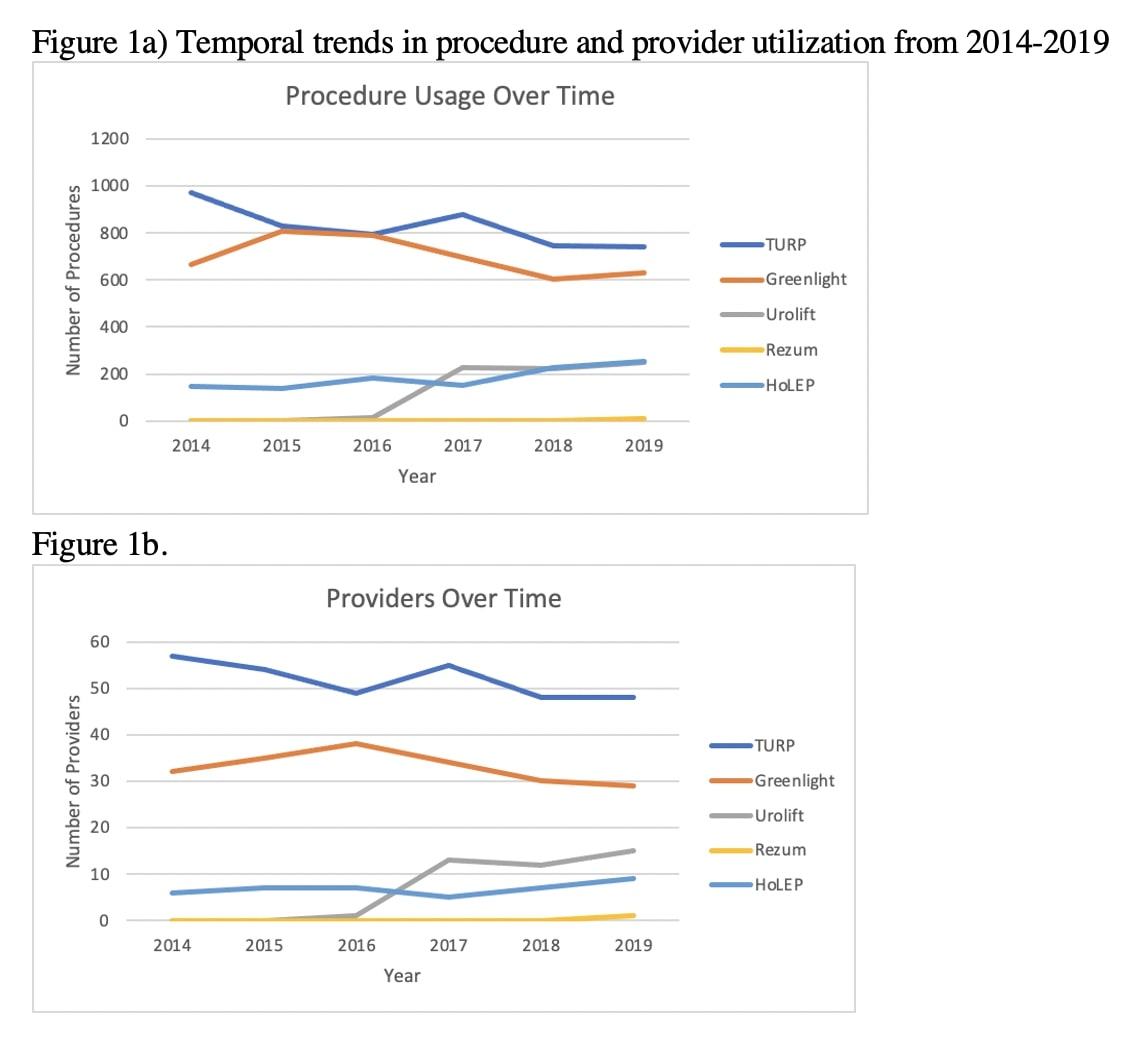Lack of Diversification in BPH Procedures Among Urologists in New England
Anna Shlimak, BS Candidate, Class of 20241, Faizanahmed Munshi, MD2, Joshua Ray Tanzer, PhD3, Rebecca Ortiz, BA1, Elias Hyams, MD2.
1Minimally Invasive Urology Institute, The Miriam Hospital, Providence, RI, USA, 2Minimally Invasive Urology Institute, The Miriam Hospital; The Warren Alpert Medical School of Brown University, Providence, RI, USA, 3The Lifespan Biostatistics Epidemiology Research Design Core, Providence, RI, USA.
BACKGROUND: There are diverse procedures available for surgical management of benign prostatic hypertrophy (BPH), with significant overlap in clinical indications but scarce comparative data. It is unclear whether providers focus or diversify their surgical BPH practices, and how practice patterns trend over time with the advent of new technologies. This information can guide patients seeking BPH care, and help urologists anticipate practice trends as new technologies emerge. In this study, we examined practice patterns in New England (NE) to assess whether urologists favor certain BPH procedures and to determine temporal trends in their surgical practice.
METHODS: A retrospective analysis of BPH procedures for urologists in NE states from 2014-2019 was conducted using publicly available Medicare data. The number of cases performed per provider was collected, including transurethral resection of prostate (TURP) (CPT 52601), Greenlight laser vaporization (52648), Urolift (52441), Rezum (53854), and Holmium laser enucleation (HoLEP) (52649). Data were analyzed for 2019 regarding practice patterns by surgeon and state. Multivariate time series analysis was used to evaluate deterministic trends (i.e., average increases or decreases) and stochastic associations (i.e., correlations across procedures) over time, to document the composition of urology procedures being used. Changes in the rates of procedures used and providers performing procedures were estimated. Note that low rates of procedures (<11) were censored for privacy reasons.
RESULTS: 93 Medicare providers performing BPH procedures in 2019. 90% performed one type, while 10% performed two, and 0% performed more than two different types of procedures (Table 1). There was variation in preference for certain procedures by state (Table 1). Longitudinal associations retrieved from 2014-2019 were highly significant and negative (in all cases, p < 0.01; in most cases, p < 0.0001), indicating providers did not increase practice diversity over time. Provider and practice trends displayed a concurrent increase in the use of Rezum and HoLEP and a decrease in TURP and Greenlight, suggesting a shift in procedure type (Figure 1). Rezum utilization remained low and nearly constant.
CONCLUSIONS: New England Urologists tend to prefer one type of procedure for BPH in Medicare patients, chiefly TURP or Greenlight. Longitudinal analysis suggests that the emergence of newer procedures does not increase the diversity of practice for providers over time. Further study is needed on whether providers should focus on a specific procedure or diversify, what volume of procedures is needed to maintain competence, and how to ensure patients are appropriately counseled given the diversity of options for surgical management of BPH.
| 1 type of procedure | 2 types of procedures | 3 types of procedures | 4 types of procedures | 5 types of procedures | |
| Connecticut | 11 | 1 | 0 | 0 | 0 |
| Maine | 11 | 0 | 0 | 0 | 0 |
| Massachusetts | 48 | 4 | 0 | 0 | 0 |
| New Hampshire | 7 | 3 | 0 | 0 | 0 |
| Rhode Island | 4 | 0 | 0 | 0 | 0 |
| Vermont | 3 | 1 | 0 | 0 | 0 |
| Providers favoring TURP | Providers favoring Greenlight | Providers favoring Urolift | Providers favoring Rezum | Providers favoring Holep | |
| Connecticut | 8 | 2 | 2 | 0 | 0 |
| Maine | 2 | 5 | 1 | 0 | 3 |
| Massachusetts | 28 | 14 | 6 | 0 | 4 |
| New Hampshire | 3 | 5 | 2 | 0 | 0 |
| Rhode Island | 2 | 1 | 0 | 0 | 1 |
| Vermont | 2 | 1 | 1 | 0 | 0 |

Back to 2022 Abstracts


